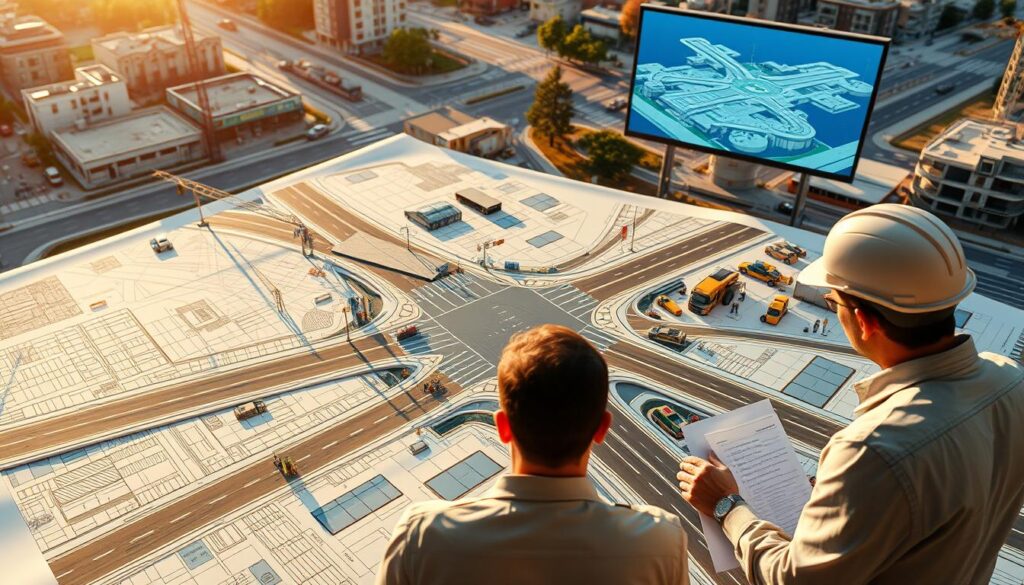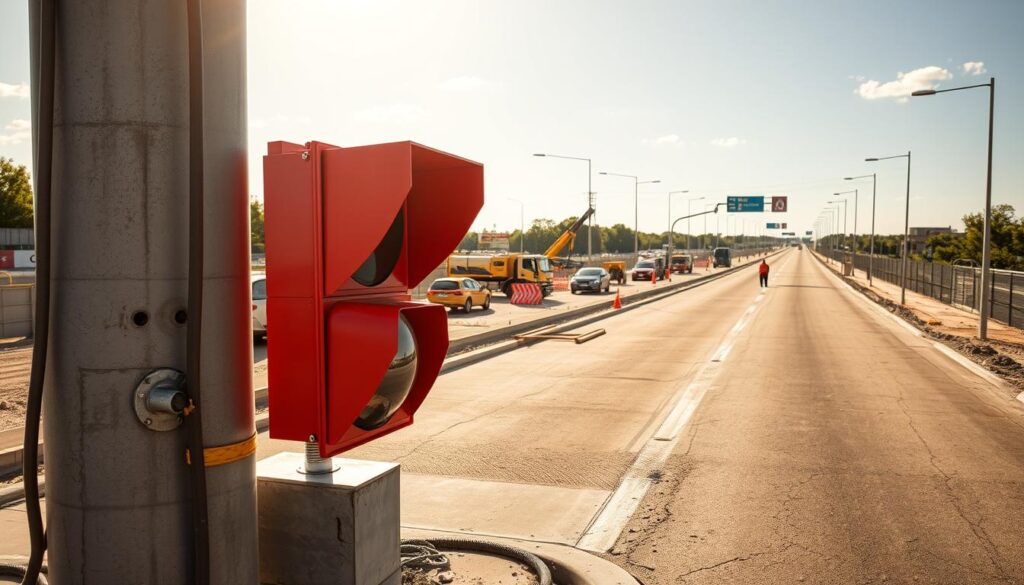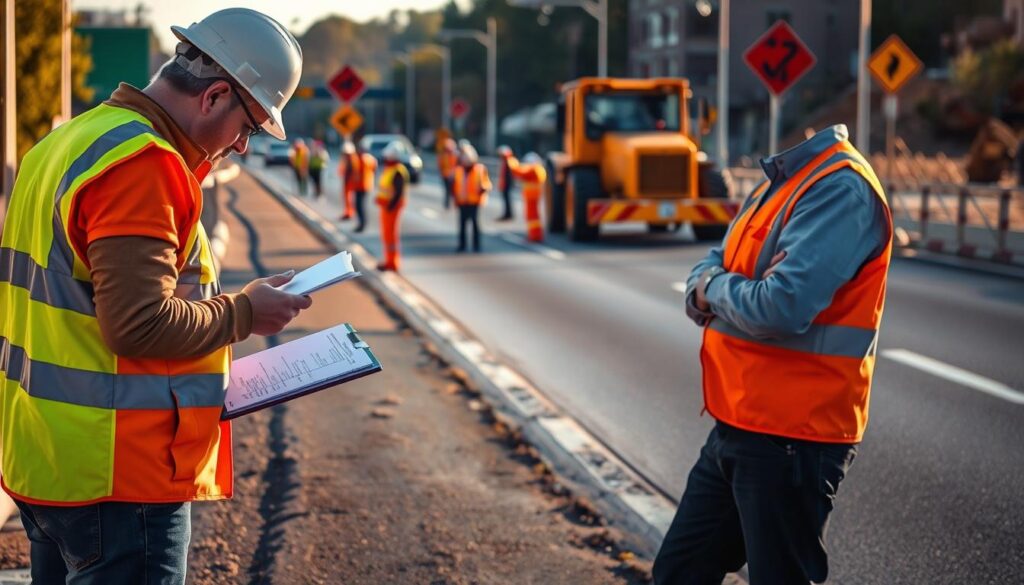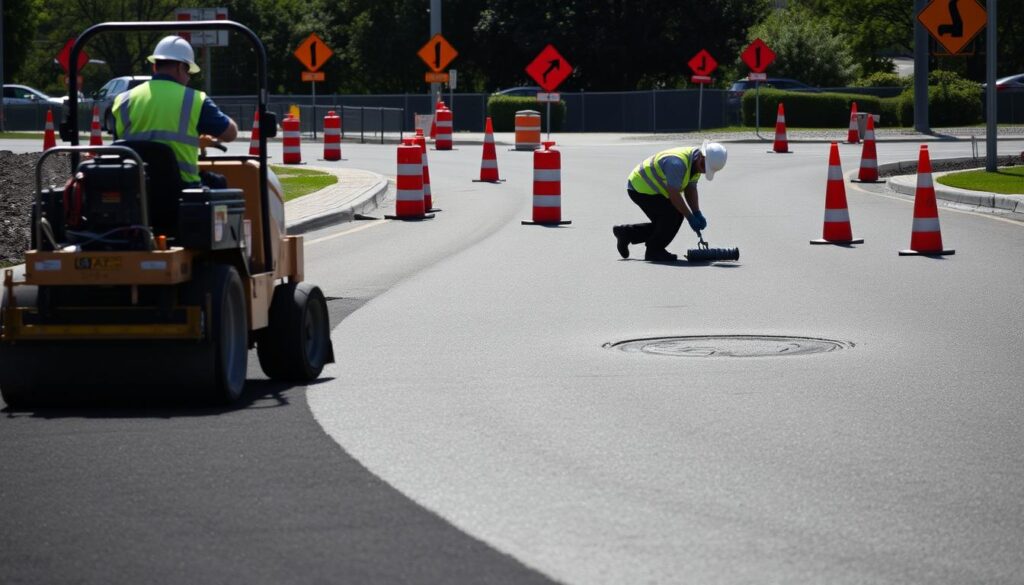Have you ever wondered what goes into building the roads we use every day? The process is complex and involves much more than just laying down asphalt.
Creating safe and durable roads requires careful planning, precise execution, and a thorough understanding of the road construction process.
The journey from planning to completion is multifaceted, involving various stages that are crucial to the success of road construction projects.
Key Takeaways
- Understanding the importance of planning in road construction.
- Exploring the design phase and its significance.
- Learning about the execution phase and its challenges.
- The role of materials in road durability.
- Ensuring safety during and after construction.
Introduction to Road Construction Projects
Infrastructure development, particularly road construction, plays a pivotal role in shaping a nation’s economic and social landscape. The construction of roads is not just about creating pathways for vehicles; it’s about connecting communities, facilitating trade, and contributing to the overall economic vitality of a region.
Importance of Infrastructure Development
Infrastructure development is the backbone of any economy, providing the foundational elements necessary for economic growth, social interaction, and environmental sustainability. Roads, in particular, are crucial as they enable the efficient movement of goods and people, thereby facilitating commerce and contributing to economic development.
The significance of infrastructure development can be seen in several areas:
- Enhanced connectivity between regions, promoting economic integration and social cohesion.
- Improved access to markets, services, and opportunities, thereby stimulating local economies.
- Increased efficiency in the transportation of goods and people, reducing costs and improving productivity.
Role of Road Construction in Economy
Road construction plays a vital role in the economy by directly and indirectly influencing various economic indicators. The construction process itself generates employment and stimulates economic activity, while the resulting infrastructure enhances the efficiency and competitiveness of the economy.
The role of road construction in the economy can be further understood by examining its impact on:
| Economic Indicator | Impact of Road Construction |
|---|---|
| Employment | Creates jobs both directly in construction and indirectly in related industries. |
| Economic Growth | Stimulates economic activity through infrastructure development. |
| Competitiveness | Enhances the efficiency of transportation, reducing costs and improving the competitiveness of local businesses. |
As illustrated, road construction is not just a physical activity but a significant economic driver that contributes to the overall development of a region.
In conclusion, road construction projects are integral to the development of a robust and interconnected infrastructure. By understanding the importance of infrastructure development and the specific role that road construction plays in the economy, we can better appreciate the complexities and benefits associated with these projects.
Planning and Design Phase
The planning and design phase is the foundation of successful road construction projects. This critical stage involves several key components that ensure the project’s viability, safety, and environmental sustainability.
Conducting Feasibility Studies
Feasibility studies are a crucial initial step in the planning phase. These studies assess the practicality of the proposed road construction project by examining various factors such as terrain, environmental impact, and budget constraints. The goal is to determine whether the project is viable and to identify potential challenges early on.
During feasibility studies, project planners consider several key aspects, including:
- Geological surveys to understand the soil and rock formations along the proposed route.
- Traffic studies to estimate the volume of traffic the road will need to accommodate.
- Economic analyses to evaluate the cost-benefit ratio of the project.
Site Surveys and Assessments
Once the feasibility of the project is established, detailed site surveys and assessments are conducted. These surveys involve mapping the terrain, identifying potential hazards, and assessing environmental conditions. The data collected during this phase is critical for designing a road that is both safe and functional.
Site surveys may include:
- Topographic surveys to map the terrain and identify any natural or man-made features.
- Environmental assessments to evaluate the potential impact on local ecosystems.
- Utility locates to identify the presence of underground utilities such as water, gas, and electricity lines.
Environmental Impact Considerations
Environmental impact considerations are a vital part of the planning and design phase. This involves assessing the potential environmental effects of the road construction project and implementing measures to mitigate any negative impacts. Strategies may include designing wildlife corridors, implementing erosion control measures, and using sustainable materials.
Key environmental considerations include:
- Minimizing habitat disruption for local wildlife.
- Reducing noise pollution through the use of noise barriers or other mitigation techniques.
- Ensuring compliance with environmental regulations and standards.

Effective road project planning and budgeting are essential for the successful completion of road construction projects. By carefully considering feasibility, conducting thorough site surveys, and addressing environmental concerns, project planners can ensure that their projects are both successful and sustainable.
Securing Funding and Budgeting
Funding and budgeting are integral components of road construction, influencing the project’s overall feasibility and execution. Effective financial planning is crucial to ensure that projects are completed on time and within the allocated budget.
Funding Sources for Road Projects
Road construction projects can be funded through various sources, including government grants, private investments, and public-private partnerships. Government grants are often allocated for projects that serve public interests, such as improving infrastructure or enhancing connectivity. Private investments, on the other hand, are typically attracted to projects that promise returns, such as toll roads.
Public-private partnerships (PPPs) have gained popularity as they allow for the sharing of risks and rewards between the public and private sectors. This model can be particularly effective for large-scale projects that require significant investment.
Cost Estimation Techniques
Accurate cost estimation is vital for the successful budgeting of road construction projects. Techniques such as unit price analysis and parametric estimating are commonly used. Unit price analysis involves breaking down the project into smaller components and estimating the cost of each unit. Parametric estimating uses historical data and statistical models to predict costs.
These techniques help in identifying potential cost overruns early on, allowing for adjustments to be made to the project plan or budget allocations.
Financial Planning and Management
Effective financial planning and management are critical to ensuring that road construction projects stay within budget. This involves not only securing funds but also managing expenditures, monitoring cash flow, and making adjustments as necessary.
Financial management also includes contingency planning for unforeseen expenses. By having a robust financial plan in place, project managers can mitigate risks associated with cost overruns and ensure the project’s financial sustainability.
Permitting and Legal Requirements
Before breaking ground on a road construction project, it’s crucial to navigate the complex landscape of permitting and legal requirements. This phase is critical in ensuring that the project complies with all relevant laws and regulations, thereby avoiding costly delays or legal repercussions.

Understanding Zoning Laws
Zoning laws dictate how land can be used and developed within a particular area. For road construction projects, understanding these laws is essential to ensure that the project aligns with local land-use plans. Compliance with zoning regulations helps in avoiding legal challenges that could halt the project.
“Zoning regulations are not just about land use; they’re about creating livable communities,” says Jane Doe, a land-use planning expert. “Road construction projects must be designed with the community’s needs in mind, adhering to zoning laws that ensure harmony between infrastructure development and environmental conservation.”
Navigating Environmental Regulations
Environmental regulations play a pivotal role in road construction, governing aspects such as water quality, wildlife habitats, and air quality. Navigating these regulations requires a thorough understanding of federal, state, and local laws. Environmental impact assessments are a crucial tool in this process, helping to identify potential environmental issues early on.
- Conduct thorough environmental impact assessments.
- Engage with local communities and stakeholders.
- Ensure compliance with all relevant environmental regulations.
By carefully managing the permitting process and adhering to legal requirements, road construction projects can proceed smoothly, minimizing the risk of legal and environmental issues. As emphasized by the Federal Highway Administration, “compliance with environmental regulations is not just a legal necessity but a step towards sustainable infrastructure development.”
Selecting Contractors and Vendors
In road construction, the selection of contractors and vendors plays a pivotal role in determining project success. The process involves several critical steps that ensure the chosen contractors are capable of delivering the project on time and within budget.
The Bidding Process
The bidding process is a transparent and competitive method used to select contractors. It involves inviting multiple contractors to submit their bids, which include their proposed costs, timelines, and methodologies for completing the project.
Key steps in the bidding process include:
- Preparing detailed bid documents that outline the project requirements and specifications.
- Advertising the bid opportunity to attract a pool of qualified contractors.
- Evaluating the submitted bids based on predetermined criteria such as price, experience, and technical capability.
Evaluating Contractor Qualifications
Evaluating the qualifications of contractors is crucial to ensure they have the necessary expertise and resources to complete the project successfully.
Factors to consider when evaluating contractor qualifications:
- Past experience in road construction projects.
- Technical expertise and equipment.
- Financial stability and capacity to undertake the project.
- Reputation and references from previous clients.
Negotiating Contracts
Once a contractor is selected, the next step is negotiating a contract that outlines the terms and conditions of the project, including the scope of work, payment terms, and timelines.
Key elements of a contract negotiation include:
- Clearly defining the scope of work and deliverables.
- Establishing a payment schedule that aligns with project milestones.
- Including provisions for potential risks and disputes.
By carefully selecting contractors and vendors through a rigorous bidding process and thorough evaluation, road construction projects can be executed efficiently and effectively.
Groundwork and Earthmoving
Earthmoving and groundwork set the stage for a durable and long-lasting road infrastructure. These initial steps are crucial in preparing the site for the construction process, ensuring a stable foundation for the road.
Clearing the Site
The first step in groundwork involves clearing the site of any debris, vegetation, and obstacles. This process is essential for a safe and efficient construction process. Site clearing not only removes unwanted materials but also allows for a thorough assessment of the land’s topography and potential challenges.

- Removal of trees and vegetation
- Clearing debris and unwanted materials
- Assessing the land for potential challenges
Excavation Processes
Following site clearing, the next step is excavation, which involves removing soil and other materials to the required depth. This process is critical for creating a stable base for the road. Excavation techniques vary depending on the terrain and the materials encountered.
| Excavation Technique | Description | Application |
|---|---|---|
| Mechanical Excavation | Using machinery like backhoes and excavators | Commonly used for most road construction projects |
| Blasting | Using explosives to break through hard materials | Used in areas with rocky or hard terrain |
Grading and Leveling Land
After excavation, grading and leveling the land are essential to achieve the desired road profile. This process ensures that the road surface is even and properly sloped for drainage. Grading involves adjusting the soil to the required grade, while leveling ensures the surface is smooth and even.
Grading and leveling are critical for the road’s structural integrity and for ensuring proper water drainage. Improper grading can lead to water accumulation, which can compromise the road’s durability.
- Adjusting the soil to the required grade
- Ensuring the surface is smooth and even
- Verifying the road profile for proper drainage
In conclusion, groundwork and earthmoving are foundational elements in road construction. By carefully clearing the site, excavating to the required depth, and grading and leveling the land, construction teams can ensure a stable and durable road infrastructure.
Drainage and Subsurface Preparation
The success of road construction heavily relies on adequate subsurface preparation and drainage. Proper drainage systems are vital to prevent water damage and ensure the longevity of the road. In this section, we will explore the importance of proper drainage and the techniques used for installing drainage systems.
Importance of Proper Drainage
Proper drainage is essential in road construction as it prevents water accumulation on the surface and within the road structure. Water can cause significant damage by weakening the roadbed, leading to cracks, potholes, and other forms of deterioration. Effective drainage systems help in redirecting water away from the road, thus maintaining its integrity and extending its lifespan.
Key benefits of proper drainage include:
- Reduced maintenance costs
- Enhanced road safety
- Prolonged road lifespan
- Prevention of waterlogging and associated damage
Installing Drainage Systems
Installing drainage systems is a critical step in subsurface preparation. These systems typically include culverts, ditches, and underground pipes that work together to manage water runoff. The design and installation of these systems require careful planning and execution to ensure they function effectively.
The following table outlines the common components of drainage systems and their functions:
| Component | Function |
|---|---|
| Culverts | Allow water to flow under the road |
| Ditches | Collect and redirect surface water |
| Underground pipes | Convey water away from the road structure |
In conclusion, proper drainage and subsurface preparation are fundamental to the success of road construction projects. By understanding the importance of drainage and implementing effective drainage systems, we can ensure the durability and safety of our roads.
Roadbed Construction
The foundation of a durable road lies in its roadbed construction, a process that demands precision and quality materials. A roadbed is the layer of material beneath the road surface, and its construction is crucial for the overall stability and longevity of the road.
Materials Used for Roadbed
The materials used for roadbed construction vary depending on the project’s requirements and environmental conditions. Common materials include aggregates like crushed stone, gravel, and sand, which provide a stable base. In some cases, stabilized soils or recycled materials may be used to enhance durability and reduce environmental impact.

Compaction Techniques
Compaction is a critical step in roadbed construction, as it ensures the stability and density of the roadbed. Various compaction techniques are employed, including vibratory compaction and static compaction, using machinery like rollers and compactors. The choice of technique depends on the material used and the project’s specifications.
Testing the Roadbed Integrity
After compaction, the roadbed’s integrity is tested to ensure it meets the required standards. Tests may include density tests and load-bearing capacity tests. These tests are crucial for verifying that the roadbed can support the anticipated traffic load without deforming or failing.
By carefully selecting materials, employing effective compaction techniques, and conducting thorough integrity tests, road constructors can ensure a robust and durable roadbed. This foundation is essential for the subsequent layers of the road and ultimately affects the road’s overall performance and lifespan.
Paving the Road Surface
Once the roadbed is prepared, the next critical step is paving the road surface, which requires a thorough understanding of the materials and machinery involved. Paving is not just about laying down a layer of material; it’s about creating a durable, safe, and smooth surface that can withstand various environmental conditions and heavy traffic.
Types of Road Materials
The choice of road material is crucial for the durability and performance of the road. Common materials used for paving include asphalt, concrete, and various types of surface treatments. Asphalt is widely used due to its flexibility and cost-effectiveness, while concrete is preferred for its durability and resistance to heavy traffic.
“The selection of the right material depends on several factors, including traffic volume, climate, and budget,” says an expert in road construction. “Asphalt is ideal for areas with moderate climates, while concrete is better suited for high-traffic areas or regions with extreme weather conditions.”
Paving Techniques and Machinery
The technique used for paving can significantly impact the quality of the final product. Modern paving techniques involve the use of sophisticated machinery, such as pavers and rollers, to ensure a smooth and even surface. The paver is responsible for laying down the material, while the roller compacts it to the required density.
- Pavers are equipped with advanced technology to ensure precision and uniformity.
- Rollers come in different types, including static and vibratory rollers, each suited for specific applications.
Quality Control in Paving
Quality control is paramount in the paving process to ensure that the road surface meets the required standards. This involves checking the material quality, monitoring the paving process, and conducting regular tests on the finished surface. Techniques such as density testing and surface roughness measurements are used to assess the quality of the pavement.
| Quality Control Measure | Description | Importance |
|---|---|---|
| Density Testing | Measures the compaction density of the pavement. | Ensures the pavement can withstand traffic loads. |
| Surface Roughness | Assesses the smoothness of the pavement surface. | Affects ride quality and safety. |
By focusing on these critical aspects, road constructors can ensure that the paved surface is not only durable but also safe for users. Effective paving techniques and quality control measures are essential for achieving a high-quality road surface that meets the needs of the community.
Installing Road Features
Properly installed road features are crucial for guiding traffic, enhancing safety, and improving accessibility. These features are the final touches that transform a constructed road into a safe and functional thoroughfare.
Curbs, Gutters, and Sidewalks
Curbs, gutters, and sidewalks are fundamental components of urban road infrastructure. They not only guide vehicular traffic but also provide safe pathways for pedestrians. The installation of these features requires precision to ensure they are both functional and durable.
Curbs serve as a barrier between the road and pedestrian paths, helping to guide vehicles and prevent erosion. Gutters are essential for directing water flow away from the road surface, reducing the risk of flooding and erosion. Meanwhile, sidewalks provide a safe area for pedestrians, separating them from vehicular traffic.

Signage and Traffic Control Devices
Signage and traffic control devices are critical for managing the flow of traffic, providing information to drivers, and enhancing safety. These devices include traffic signs, road markings, and traffic signals.
The installation of traffic signs is guided by strict regulations to ensure they are visible and understandable. Road markings are used to guide traffic and provide visual cues to drivers. Traffic signals are installed at intersections to manage the flow of traffic, reducing congestion and the risk of accidents.
Effective installation of these devices requires careful planning and execution to ensure they serve their intended purpose and contribute to a safe and efficient traffic environment.
Landscaping and Final Touches
The final stages of road construction involve more than just paving; they include landscaping and erosion control. As the infrastructure nears completion, the focus shifts to ensuring that the project is environmentally sustainable and aesthetically pleasing.
Effective landscaping not only enhances the visual appeal of the road but also plays a critical role in integrating the infrastructure into the surrounding environment. This is where native plant landscaping comes into play.
Native Plant Landscaping
Native plant landscaping involves using plants that are indigenous to the area. This approach has several benefits, including reduced maintenance costs, as native plants are adapted to the local climate and soil conditions, requiring less watering and care.
Benefits of Native Plant Landscaping:
- Reduced water consumption
- Lower maintenance costs
- Enhanced biodiversity
- Improved ecosystem services
As noted by environmental experts, “Using native plants in landscaping can significantly reduce the environmental footprint of road construction projects.”
“Native vegetation helps in maintaining ecological balance and supports local wildlife.”
Erosion Control Measures
Erosion control is another critical aspect of the final stages of road construction. Without proper measures in place, erosion can lead to significant environmental damage and maintenance issues.
Erosion control techniques include the use of geotextiles, planting vegetation, and constructing retaining walls. These measures help stabilize the soil and prevent erosion, especially in areas with heavy rainfall or steep slopes.
Road Safety and Compliance Testing
Road safety and compliance testing are crucial steps that validate the integrity and usability of road infrastructure. These processes ensure that the road is not only safe for users but also complies with the regulatory requirements set by state and federal authorities.
Ensuring Safety Through Inspections
Conducting Safety Inspections
Safety inspections are a critical component of road safety and compliance testing. These inspections involve a thorough examination of the road infrastructure to identify any potential hazards or defects. Inspectors check for compliance with safety standards, including the condition of the road surface, signage, and traffic control devices.
Inspectors use various techniques and tools to assess the road’s condition. This includes visual inspections, as well as the use of specialized equipment to measure factors such as road surface friction and drainage efficiency.

Compliance with State and Federal Guidelines
Compliance with state and federal guidelines is essential to ensure that roads are safe and durable. Regulatory bodies set specific standards for road construction, including materials used, design specifications, and safety features. Compliance testing involves verifying that these standards have been met during the construction process.
This includes testing the road’s structural integrity, ensuring that drainage systems are functioning correctly, and verifying that all safety features, such as signage and guardrails, are installed according to regulations.
Key Aspects of Compliance Testing
- Verification of construction materials against specified standards
- Assessment of road design and geometry for safety and efficiency
- Evaluation of safety features and traffic control devices
By conducting thorough safety inspections and compliance testing, authorities can ensure that roads are safe for public use and meet the required regulatory standards.
Opening the Road to Traffic
Opening the road to traffic is the culmination of a complex process that involves thorough inspection and public notification. This final stage is crucial as it ensures the road is safe for use and that the public is aware of the changes.
Final Inspection Checklist
A comprehensive final inspection is vital to guarantee the road meets all safety and quality standards. The inspection checklist typically includes:
- Checking the road surface for any defects or damage
- Verifying that all signage and traffic control devices are correctly installed
- Ensuring that drainage systems are functioning properly
- Inspecting the roadbed for stability and compaction
Conducting a thorough final inspection helps identify any issues that need to be addressed before the road can be safely opened to traffic. This step is critical in preventing accidents and ensuring the longevity of the road.
Public Notification and Awareness
Public notification is an essential component of opening a new road to traffic. It involves informing the public about the road’s opening through various channels, such as local news outlets, social media, and official announcements. Effective public notification helps in managing traffic flow and reducing confusion among road users.
A well-planned public notification strategy includes:
- Releasing information about the road opening well in advance
- Providing details on any traffic adjustments or detours
- Utilizing multiple communication channels to reach a wide audience
By combining a thorough final inspection with effective public notification, the process of opening the road to traffic can be carried out smoothly and safely.
Maintenance Considerations
Effective maintenance considerations are crucial for the longevity and safety of road infrastructure. Maintenance is not just about repairing damages but also about preventing deterioration to ensure the road remains functional and safe for users.
Routine Maintenance Practices
Routine maintenance practices are essential to extend the life of the road. These practices include regular inspections to identify potential issues before they become major problems. Preventive maintenance is a key strategy that involves activities like crack sealing, pothole repair, and resurfacing.
- Regular cleaning of drainage systems to prevent clogging
- Inspecting and repairing road signs and markings
- Maintaining roadside vegetation to prevent overgrowth
According to a study by the American Association of State Highway and Transportation Officials, regular maintenance can significantly reduce the need for costly repairs over time. “Investing in maintenance is not just a cost; it’s a strategy to preserve the infrastructure,” says a transportation expert.
“The key to successful road maintenance is not just fixing the immediate problems but also planning for the long term.”
Long-term Infrastructure Planning
Long-term infrastructure planning involves assessing the condition of the road network and forecasting future needs. This includes evaluating traffic volume, road condition, and environmental factors to determine the most effective maintenance strategies.
| Maintenance Activity | Frequency | Benefits |
|---|---|---|
| Crack Sealing | Annually | Prevents water infiltration, reducing pothole formation |
| Resurfacing | Every 10-15 years | Restores road surface, improving safety and ride quality |
| Drainage System Cleaning | Bi-Annually | Ensures proper water flow, reducing erosion and damage |
By incorporating these maintenance considerations into the overall infrastructure plan, transportation agencies can ensure that roads remain safe and functional for years to come.

Conclusion and Future of Road Construction
The process of road construction is complex, involving multiple steps from planning to completion. As we look to the future, it’s clear that innovations in road construction and a focus on sustainability will play a crucial role in shaping the industry.
Emerging Trends
New technologies and materials are being developed to improve the durability and environmental sustainability of roads. The future of road construction will likely involve the increased use of recycled materials, advanced drainage systems, and innovative paving techniques.
Sustainable Practices
Sustainability will continue to be a key consideration in future road construction projects. This includes not only the use of environmentally friendly materials but also practices that minimize the environmental impact of construction, such as reducing waste and preserving natural habitats.
By embracing these innovations and sustainable practices, the road construction industry can build roads that are not only safer and more durable but also more environmentally friendly, meeting the needs of both today and tomorrow.
